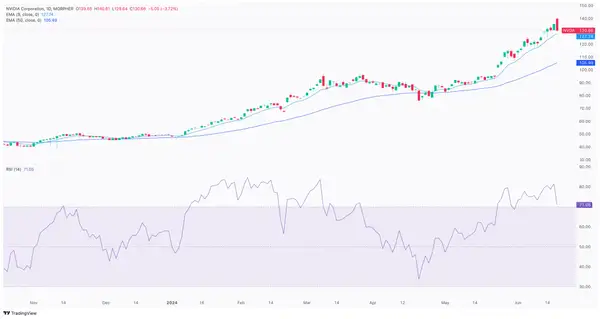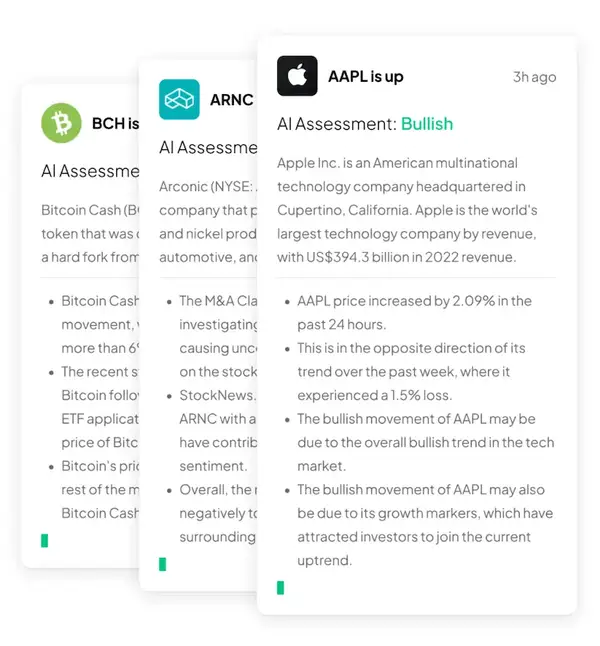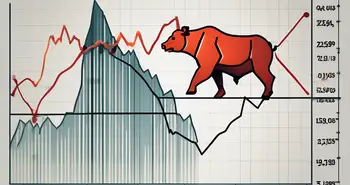NVIDIA: The Future of AI or the Next Dot-Com Bubble?

Did you know that NVIDIA Corporation (NASDAQ: NVDA) has seen its stock price surge over 150% in the past year alone? This astonishing growth has made NVIDIA one of the most valuable companies in the world, with a market capitalization exceeding $1 trillion. As the company continues to push the boundaries of innovation in artificial intelligence (AI), graphics processing units (GPUs), and autonomous vehicles, there is an ongoing debate about whether NVIDIA’s soaring stock price resembles the dot-com bubble of the late 1990s. This article provides an overview of NVIDIA, recent market developments, a technical analysis, and a comparison with the dot-com bubble to arrive at a well-rounded conclusion.
The Rise of of NVIDIA Corporation (NVDA)
Nvidia's journey from a relatively unknown graphics company to a global tech powerhouse is nothing short of remarkable. Founded in 1993, Nvidia initially focused on producing graphics cards for personal computers. However, it quickly gained recognition for its innovative technologies and became a key player in the gaming and semiconductor industries.
Over the years, Nvidia expanded its product line beyond graphics cards, venturing into artificial intelligence, data centers, and autonomous vehicles. The company's ability to adapt and capitalize on emerging technologies has been a driving force behind its impressive growth. Nvidia's GPUs, known for their ability to handle complex computations, have become essential tools for various industries, including gaming, AI research, and cryptocurrency mining.
Several factors have contributed to Nvidia's rise to prominence. Firstly, the increasing demand for high-quality graphics and realistic gaming experiences has propelled the company's gaming segment to new heights. Additionally, the growing adoption of AI and machine learning applications has created a lucrative market for Nvidia's GPUs, which excel at processing massive amounts of data in parallel. Furthermore, Nvidia's strategic partnerships with leading tech companies have helped expand its reach and influence in the industry.
Recent Market Developments Impacting NVIDIA's Stock Price
To provide a detailed and precise overview of recent market developments that have impacted NVIDIA's stock price, here are some significant real-life updates:
- U.S. Department of Justice (DOJ) Antitrust Probe: In June 2024, the DOJ announced an antitrust investigation into NVIDIA's AI activities. This news caused concern among investors, leading to a slight decline in the stock price. The probe aims to determine if NVIDIA's practices in the AI sector have violated antitrust laws .
- Record Quarterly Earnings: NVIDIA reported record earnings for the first quarter of fiscal 2025, with revenue reaching $26.04 billion, a significant increase from $7.19 billion in the previous year. This remarkable growth was driven by strong demand for GPUs in data centers and AI applications. The impressive financial results contributed to a surge in NVIDIA's stock price.
- Product Launches and Innovations: NVIDIA introduced several new products and technologies, including the NVIDIA Omniverse™ Cloud APIs for industrial digital twins and the next-generation NVIDIA DRIVE Thor™ platform for electric vehicles. These innovations have strengthened NVIDIA’s position in various high-growth markets, positively influencing its stock price.
- AI and Data Center Expansion: The growing adoption of NVIDIA’s GPUs for AI research and data center operations has been a significant revenue driver. Partnerships with major tech companies and organizations have further solidified NVIDIA’s market leadership, contributing to investor confidence and stock price appreciation.
- Anticipation of Annual Shareholder Meeting: Investors have been eagerly anticipating NVIDIA’s annual shareholder meeting scheduled for June 26, 2024. Speculation about potential new product announcements and updates on future strategies has fueled bullish sentiment, pushing the stock to new all-time highs.
Technical Analysis Overview

Analyzing NVIDIA’s stock chart with key technical indicators provides insights into its current market position:
Short-term EMA (9-day): The stock price is currently above the 9-day EMA, indicating a strong short-term uptrend.
Long-term EMA (50-day): The price is well above the 50-day EMA, confirming a robust long-term uptrend.
Relative Strength Index (RSI): The RSI is above 70, suggesting the stock is in overbought territory and may be due for a correction.
To summarize the chart analysis, NVDA appears to have the potential to sustain its long-term uptrend, aligning with the company's growth prospects, particularly in artificial intelligence. While there isn't compelling evidence to suggest a bubble at this time, it's crucial to distinguish between a market bubble burst and a market correction. Technical indicators show that NVDA shares are currently in an “overbought” condition, significantly above their long-term price average. This large disparity might signal an impending price correction.
Unlock the full potential of your investments with Morpher.com! Access advanced charts with over 50 technical indicators, real-time market data, and comprehensive analysis tools. Plus, every Morpher user gets Morpher AI for free, providing cutting-edge AI insights, automated trading strategies, and risk management tools. Enhance your trading strategy with the best in technology. Reach out everything you need to know about NVDA market insights. Sign up today!

Market Bubble vs. Market Correction: Brief Overview
Market Bubble: A market bubble occurs when asset prices inflate rapidly to levels far beyond their intrinsic value, driven by excessive speculation and irrational investor behavior. This unsustainable growth inevitably leads to a sharp market crash when the bubble bursts, causing substantial financial losses.
Market Correction: A market correction is a natural and healthy market adjustment where asset prices decline by at least 10% from recent highs. Corrections realign asset values with their true economic and financial conditions and are typically short-lived, followed by market recovery.
For a more detailed explanation of market bubbles and corrections, including historical examples and in-depth analysis, check our detailed guide here.
Is NVIDIA in a Bubble Similar to the Dot-Com Bubble?
The comparison between NVDA (NVIDIA Corporation) and the dot-com bubble often arises due to the rapid growth and high valuation seen in the technology sector, drawing parallels to the late 1990s and early 2000s dot-com era. Here’s an overview of the dot-com bubble, the similarities, and the differences observed with NVDA:
The Dot-Com Bubble: Overview
The dot-com bubble was a period of excessive speculation in the late 1990s, characterized by a rapid rise in equity markets fueled by investments in Internet-based companies. Many of these companies, commonly referred to as dot-coms, saw their stock prices soar without having a sustainable business model or substantial revenue. The bubble peaked in March 2000, followed by a sharp decline in stock prices, leading to significant financial losses for investors.
Similarities Between NVDA and the Dot-Com Bubble
- Rapid Growth and High Valuations: Both periods are marked by exceptional growth and skyrocketing stock prices in the technology sector. NVDA has seen a significant increase in its stock price due to its leadership in graphics processing units (GPUs) and artificial intelligence (AI).
- Investor Enthusiasm: Just like during the dot-com era, there is considerable enthusiasm and optimism about future technologies. For NVDA, this optimism is centered around AI, autonomous driving, and other cutting-edge technologies.
- Speculative Investments: There are concerns that investments in tech stocks, including NVDA, might be speculative, driven more by future potential rather than current financial performance. This speculative behavior was a hallmark of the dot-com bubble.
Differences Between NVDA and the Dot-Com Bubble
- Solid Business Model and Revenue: Unlike many dot-com companies that had little to no revenue, NVDA has a well-established business model with substantial revenue and profits. NVDA’s products are widely used in gaming, data centers, and professional visualization, providing a strong revenue base.
- Technological Leadership: NVDA is a leader in GPU technology and AI, with tangible products and services that are critical to various industries. The dot-com bubble had many companies with unproven technologies and business concepts.
- Broader Market Use and Adoption: The technologies driving NVDA’s growth, such as AI and GPUs, have broad market adoption and are critical to advancements in various fields. In contrast, many dot-com companies were based on concepts that had not yet been tested or adopted widely.
- Regulatory and Market Environment: Today’s market is more regulated, and there are more stringent reporting requirements for public companies. The regulatory environment during the dot-com bubble was less developed, allowing for more speculative and risky investments.
While there are surface-level similarities between the current rise of NVDA and the dot-com bubble in terms of rapid growth and high valuations, the underlying factors are significantly different. NVDA is supported by robust technology, a solid business model, substantial revenue, and broad market applications. However, investor caution is always warranted to avoid speculative excesses that characterized the dot-com bubble. By understanding these distinctions, investors can better navigate the potential risks and opportunities associated with NVIDIA’s stock.
FAQs
What is a market bubble?
A market bubble occurs when the price of an asset becomes detached from its intrinsic value, leading to an unsustainable increase driven by speculation and hype.
What factors have contributed to Nvidia's success?
Nvidia's success can be attributed to its ability to adapt and innovate, strong partnerships with leading tech companies, increasing demand for high-quality graphics and AI applications, and the growing adoption of its GPUs in various industries.
What are the potential risks of investing in Nvidia?
Potential risks include market volatility, regulatory challenges, and the possibility that the stock price may not continue to reflect the company's actual value.
What are the potential rewards of investing in Nvidia?
Potential rewards include Nvidia's role in the future of technology, its strong financial performance, and the company's ability to capitalize on emerging markets and technologies.
Is Nvidia a bubble or a solid investment opportunity?
Opinions among experts vary. While Nvidia's rapid rise in stock price has raised concerns, its strong fundamentals and strategic positioning suggest that it may be a solid investment choice. However, investors should carefully evaluate the risks and rewards before making any investment decisions.
Remember, investing involves risks, and it is essential to do your own research and seek professional advice before making any investment decisions.
As you consider the potential risks and rewards of investing in companies like Nvidia, it's crucial to have the right tools and platform that can adapt to your investment strategy. Morpher.com offers a revolutionary trading experience that aligns with the innovative spirit of companies transforming technology. With zero fees, infinite liquidity, and the ability to engage in fractional investing and short selling, Morpher empowers you to trade on your terms. Experience the safety and control of a non-custodial wallet, the potential of 10X leverage, and the unique trading opportunities provided by Virtual Futures. Ready to elevate your trading game? Sign Up and Get Your Free Sign Up Bonus at Morpher today and join the future of investing.

Disclaimer: All investments involve risk, and the past performance of a security, industry, sector, market, financial product, trading strategy, or individual’s trading does not guarantee future results or returns. Investors are fully responsible for any investment decisions they make. Such decisions should be based solely on an evaluation of their financial circumstances, investment objectives, risk tolerance, and liquidity needs. This post does not constitute investment advice.

Painless trading for everyone
Hundreds of markets all in one place - Apple, Bitcoin, Gold, Watches, NFTs, Sneakers and so much more.

Painless trading for everyone
Hundreds of markets all in one place - Apple, Bitcoin, Gold, Watches, NFTs, Sneakers and so much more.









